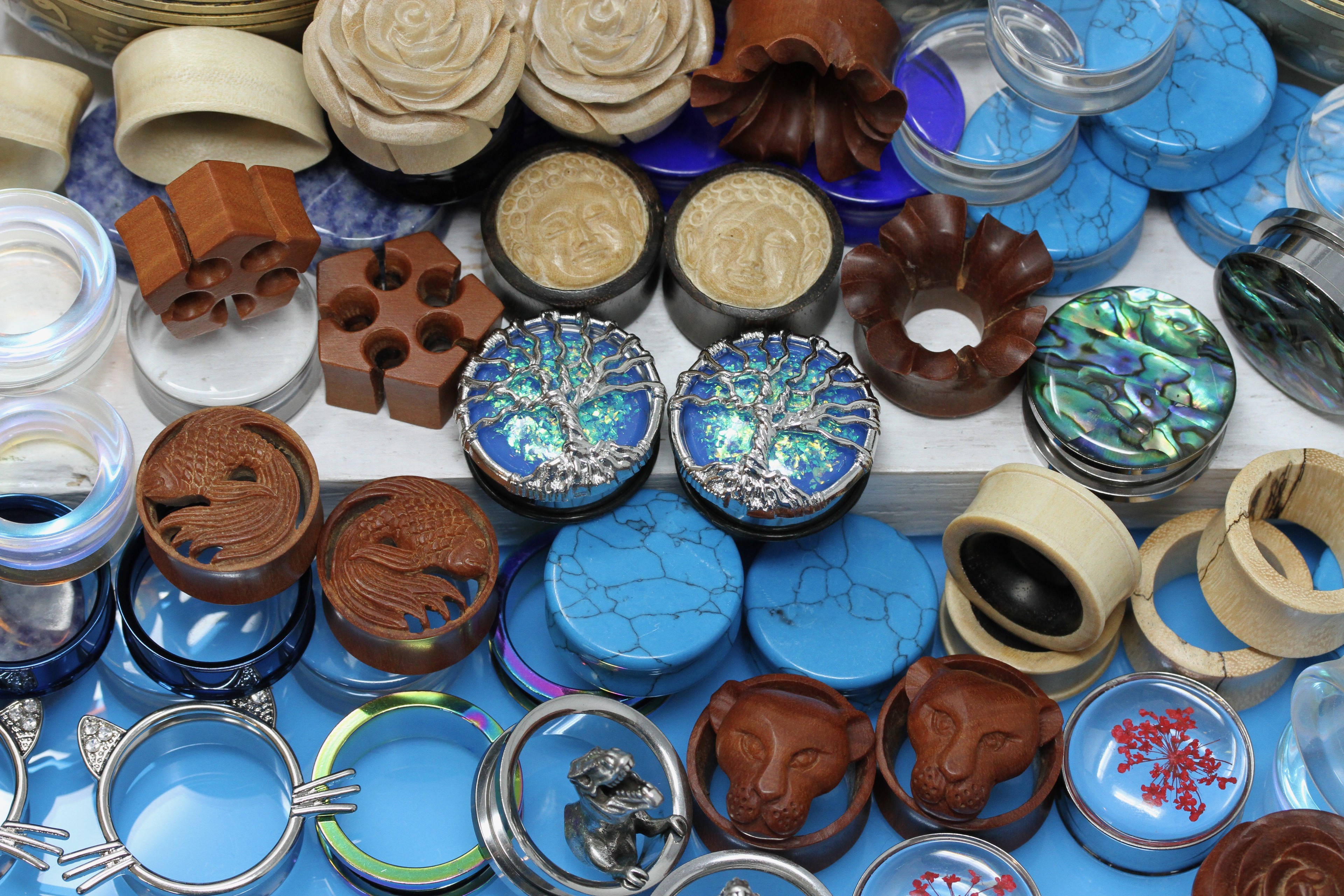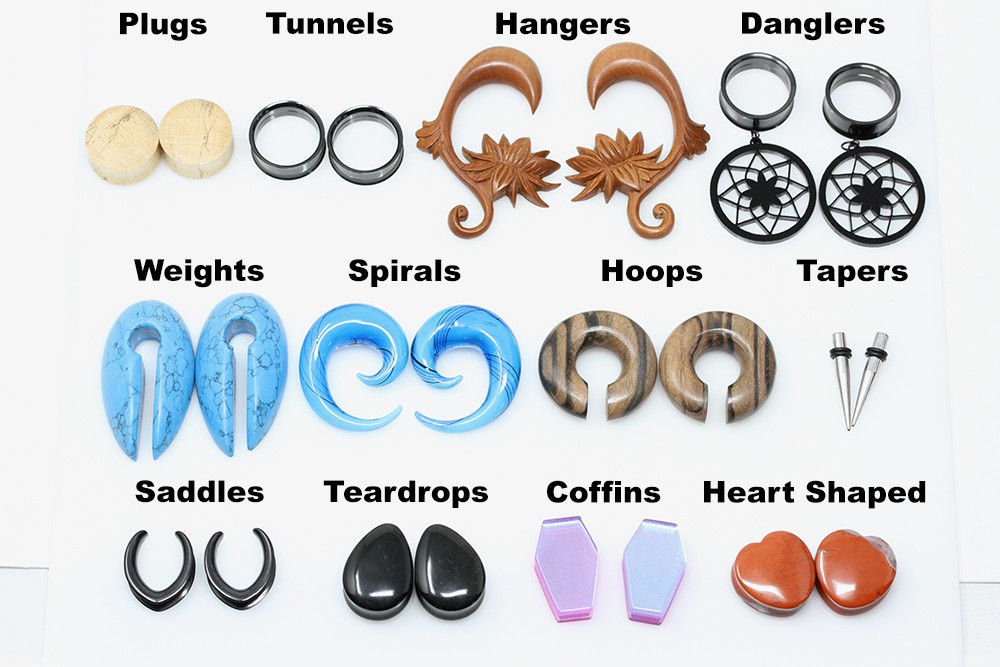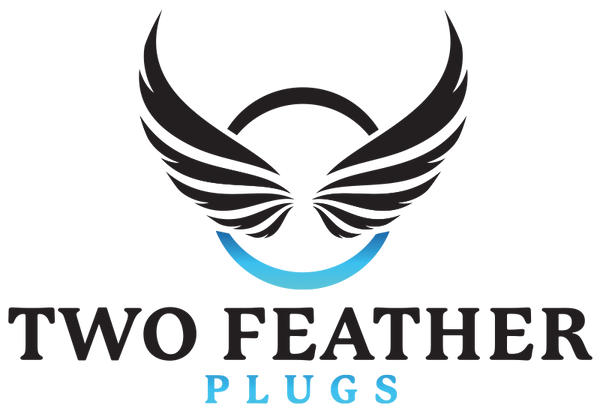Common Terms for Stretched Ears
April 15, 2022 / by Alex Peace

If you are new to the world of ear stretching you may be wondering what everything means. What is the difference between an ear gauge and a plug? Why do we even use the term gauge for ear plugs? What is an ear hanger versus an ear dangler?
Two Feather Plugs wants you to know what everyone in the community is talking about so we created this "Learn the Terms" blog so you can learn all the basics for stretching your ears. If you ever have any questions about stretching your ears please feel free to contact us directly. Or follow more of our blogs for the latest about stretching your ears
Click for Ear Stretching Blog
What is the difference between an Ear Plug and an Ear Gauge?
The term Ear plug refers to the actual jewelry that fits in your ear. The term plug refers to the solid jewelry that will fit inside the hole in your ear. The term ear gauge is referring to the measurement of the hole in your ear. Gauge is like inches or millimeters. So when you are talking about the jewelry in your ear you would use the term ear plugs. When you are talking about the size of your plugs you would be using the term ear gauges.
Ear Plugs will come in different gauge sizes. Gauge sizes start from a high number and decrease from there. Typically you will start at a 14 gauge plug and stretch up to a 0 gauge plug.
14 gauge - 1.6mm - 1/16 inch
12 gauge - 2mm - 5/64 inch
10 gauge - 2.5mm - 3/32 inch
8 gauge - 3mm - 1/8 inch
6 gauge - 4mm - 5/32 inch
4 gauge - 5mm - 3/16 inch
2 gauge - 6mm - 1/4 inch
0 gauge - 8mm - 5/16 inch
00 gauge - 10mm - 3/8 inch
Common Ear Stretching Terms
Types of Ear Stretching Jewelry
Plugs - Plugs are solid jewelry that goes into the holes in your ears. The ear plugs come in several different types of material and different sizes depending on the gauge of your ear. They also typically cut in either single flare or double flare.
Tunnels - Ear Tunnels are like plugs only they have holes in the center of the plugs so you can see completely through the hole in your ears. Much like plugs, the tunnels come in different materials and different types of cuts single or double flared. Shop all our Ear Tunnels
Ear Hangers - Hangers hang from the hole in your ears. Typically the top part will be at a thickness to stay in your ear. The gauge of the hanger will vary to fit in the hole in your ear. The rest of the hangers will curve from the hanger and hang from the rest of the jewelry.
Ear Danglers - Danglers are like Hangers, but they typically dangle from tunnels or plugs. The tunnel will come in different ear gauge sizes and the jewelry will dangle from the tunnel
Ear Weights - Ear weights have a weight to them so they will stretch out the bottom of your ears. You typically will see the bottom of the lobe stretch down from the weight of the ear weight. Typically the ear weight material will be heavier like stone or metal. Shop all our Ear Weights
Ear Spirals - Spirals will be cut from the center and corkscrew around the center. One side will be pointed and will gradually work its way up to the proper gauge size of your hole. Shop all our Ear Spirals
Ear Hoops - Hoops are a simple circle with one section cut out so the ear hoops can fit into the hole in your ear. They come in different ear gauge sizes and are also made in different materials.
Ear Tapers - Ear Tapers are used as a tool to help stretch your ears. They are a long cone shape tool that typically comes in a kit. The kit will come in different gauges to help stretch your ears. Typically you use the ear taper as a tool to get a single flare plug into your stretched ear. For more information click on Ear Tapers
Ear Saddles - Saddles sit in your ear like a "u" shaped plug. They sit in the hole of your ear so the top of the saddle is open.
Coffin Plugs - Coffin plugs are shaped plugs that fit in your stretched ears. Coffin plugs are only to be used for a short period of time. They are sized with your ear gauge in mind. So if you typically wear a 0 gauge round plug you would order a 0 gauge coffin plug.
Teardrop Plugs - Teardrop plugs are shaped plugs that will fit in your stretched ear. They are sized with your ear gauge in mind. So if you typically wear a 00 gauge round plug you would order a 00 gauge teardrop plug. Shop all our Teardrop Plugs

Terms for keeping your stretched ears healthy
Jojoba Oil - Jojoba oil is our recommend natural oil that we use in many aspects of stretching your ear. It can be a lubricant to help get your plugs in your stretched ears. Jojoba oil can also be massaged into your stretched ears to help with elasticity and also kill bacteria in your ears. Also, we use Jojoba oil to clean our plugs and hangers. It is a must-have while stretching your ears.
Ear Blowout - A blowout happens 99% of the time due to trying to stretch your ears too fast. What happens is the ear try to hear itself and scar tissue starts to form. An ear blowout often makes the hole in your lobe is turned inside out. The best way to not get an ear blowout is to slow down. For more information click on Ear Stretching Blowouts
Salt Soak - A salt soak is a great way to keep your ears clean and healthy. It helps keep your stretched ears clear of infection. Click here for more information on a Salt Soak for Stretching your Ears
Ear Keloids - Keloids are common after a piercing. It is overgrown scar tissue that forms on your ear because of trauma like a piercing.
Safe Ways to Stretch your Ears
Please note that you should consult a professional before stretching your ears using any of these methods. If you feel pain while stretching to the next gauge size you probably are moving too fast.
Ear Tapers - Tapers are a great tool to stretch your ears. The ear taper is a stainless steel cone-shaped tool that should slowly go into your ear and help stretch the ear and should be followed by a single flared stainless steel plug to help keep the ear stretched to its new gauge size. For more information click here Ear Tapers
Tape Ear Stretching - Using PTFE or bondage tape is probably the simplest way to stretch your ear. This method adds a thin layer of tape to the existing plug and reinsert the plug back into your ear. This helps you slowly get to the next ear gauge. Move slowly.
Debatable ways to stretch your ears
Dead Stretching Ears - Dead stretching has gotten a bad wrap as of late, but it is also the most common method. People say you should not dead stretch because you are forcing a larger ear plug through the fistula when the fistula is too small. Well, we agree don't do this. But when you have round plugs in your ears and if they have a little weight to them your ears naturally start to stretch over time. As time goes on your plugs might actually start falling out of your ears. If this is the case you actually dead stretched to the next gauge size. Nerve force a larger size into your ears. They should naturally go in.
Ear Weights - Ear Weights work on gravity. The weight will hang from the bottom of the lobe and stretch your ear over time. We typically do not recommend stretching your ears using this method. As they cause your ears to stretch unevenly. However, we have found that with some customers who have stuck or stubborn larger sizes this helps get it unstuck and helps stretch to the next size. Click to shop our Ear Weights
Not Recommended Ways to Stretch your Ears
Dermal Punch - A circular razor is pushed through and twisted through the skin of the ear. The size of the blade may vary in gauge size. A glass plug is often placed in the ear to keep the ear stretched. Again this is not one of our favorite options to stretch your ears. Do not attempt this without professional help.
Ear Scalpelling - Sometimes scar tissue or thin tissue will make it harder for your ear to continue to stretch. For instance, if someone has two separate holes in their ear the tissue in between may become rigid. In this case, it might be easier to use a scalpel and combine the two holes into one. This is not a common practice. Typically this is the last option while stretching your ears, and should be done by a professional
Silicone Plugs - Silicone plugs should not be used to stretch your ears. If you insist on wearing silicone plugs they should be worn after the ear is healed. Silicone plugs are porous and will hold onto bacteria. So while your ear is stretching is prone to this bacteria that will lead to infection in your stretched ears.






